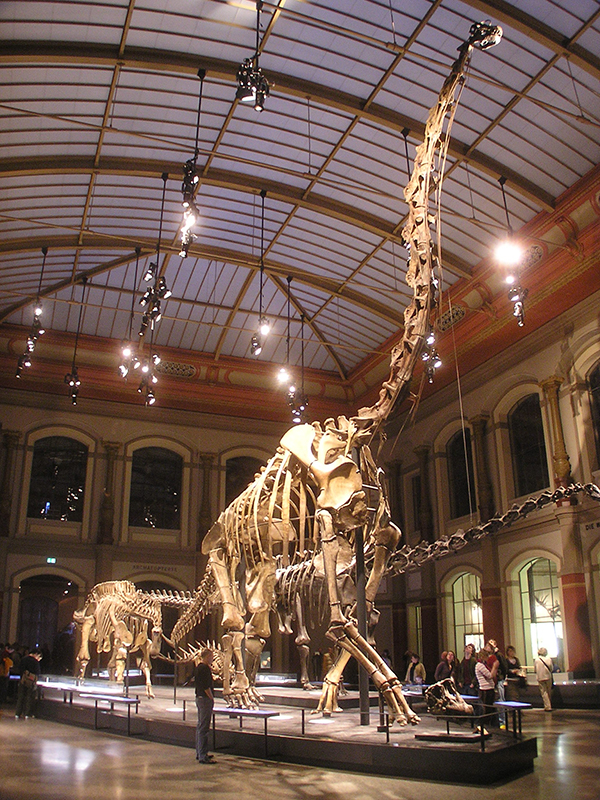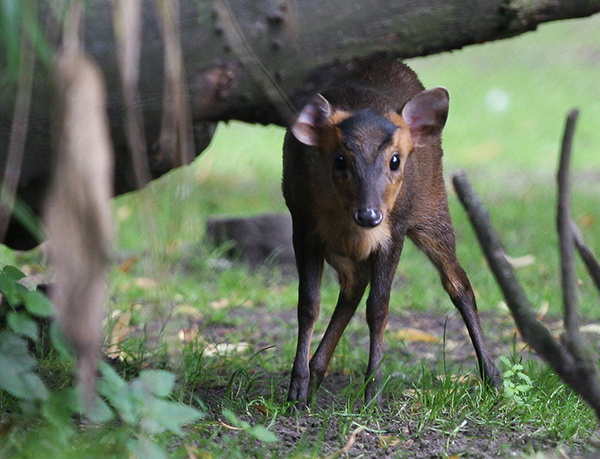
by Lucas Joel Friday, July 6, 2012

Skeleton of the _Giraffatitan brancai_ at the Museum für Naturkunde in Berlin, Germany. This is the largest mounted dinosaur skeleton in the world. Axel Mauruszat

Meike Köhler and colleagues looked at rest lines in the bones of modern ruminants like the _Muntiacus _deer to compare them to rest lines in dinosaurs. Courtesy of Meike Köhler
We may know a lot about dinosaurs, but there’s an awful lot we don’t know yet, especially about their biology. How heavy were the dinosaurs? Were they fast or slow? Recent research poses new answers to these long-standing questions.
The largest mounted dinosaur skeleton — that of Giraffatitan brancai — stands in the halls of Berlin’s famous Museum für Naturkunde. From this skeleton, we know G. brancai was about 12 meters tall and more than 21 meters long, but how heavy the original animal was has remained a mystery. Estimates of dinosaur weights have varied greatly over the years, partly because drawing the boundary lines of dinosaur bodies has usually fallen to the individual researcher’s artistic judgment.
However, in a study published last month in Biology Letters, computational zoologist William Sellers from the University of Manchester in England presented a new, objective method for estimating vertebrate animal weights.
Using laser technology known as lidar (Light Detection and Ranging), Sellers scanned the mounted skeletons of 14 modern, large-bodied mammals on display at the Oxford University Museum of Natural History. From the scans, Sellers used a computer to construct a digital, 3-D “hull” around each skeleton. The hulls provide a minimum volume which, when multiplied by the mammals' known body densities, provides weight estimates.
“We found our calculated weights to be consistently about 20 percent less than the mammals’ actual living weights,” Sellers says. “This consistency is encouraging because it means we can derive reliable weight values just by scanning mounted skeletons.”
Sellers then turned the lidar on G. brancai, and the results show that the dinosaur probably weighed close to 23 tons — about equal to three or four male African elephants.
“This G. brancai weight falls smack in the middle of what has previously been reported,” says Heinrich Mallison, a paleontologist at the Museum für Naturkunde who was not involved in Sellers’ research. “Now we just need to see how well the technique works with living reptiles, which are more closely related to dinosaurs than modern mammals,” Mallison says. “This will give us an even better idea of how much dinosaurs may have weighed.”
Accurately estimating dinosaur weights has important implications for reconstructing dinosaur lifestyles. For instance, back in the 1960s, G. brancai was estimated to weigh about 80 tons — a result influenced by the popular view that dinosaurs did nothing but eat, and were thus very heavy, very slow animals.
Modern research, though, is revealing that dinosaurs were probably anything but slow.
In a paper published last week in Nature, a research team led by Meike Köhler of the Catalan Institute of Paleontology (Autonomous University of Barcelona) in Spain presented evidence supporting the view that dinosaurs were endothermic, or warm-blooded.
If dinosaurs were warm-blooded, then they were likely agile and fast (as featured in the film “Jurassic Park”). If they were cold-blooded, then they were probably sluggish and plodding, like crocodiles.
Köhler, who sawed segments from the leg bones of more than 100 modern ruminants (a mammal group that includes antelope and reindeer), found that, contrary to previous assumptions, mammalian bone tissues record what are known as rest lines, or lines of arrested growth (LAGs) — kind of like tree rings. LAGs were previously thought to only occur in the bones of ectothermic vertebrates because ectotherms rely on their environment to regulate their metabolism: When resources are scarce, bone growth halts. When resources become more plentiful, bone growth resumes.
But there has never been a systematic study on the rest lines of mammals, Köhler says. “Because mammals grow so fast, nobody thought LAGs should form,” she says. “Our study shows that not only do fast-growing, warm-blooded mammals like ruminants exhibit seasonal bone growth, but also that the fast-growing tissue between LAGs is almost identical to dinosaur tissue.”
So, does this mean dinosaurs were warm-blooded?
It’s pretty likely, says Kevin Padian, a paleontologist at the University of California at Berkeley who was not involved in Köhler’s work. But it’s also pretty clear that the warm-blooded/cold-blooded topic is less a two-way street, he says, and more a continuum between those organisms that have significant fluctuations in internal body temperatures and those that do not.
“More important to consider are the relatively high dinosaur growth rates, which indicate an underlying physiology that must have been operating at much higher rates than animals we would describe as ectotherms,” Padian says.
For future research, Köhler says more mammal and dinosaur bone tissue samples need to be compared so as to further constrain dinosaurian bone growth patterns.
© 2008-2021. All rights reserved. Any copying, redistribution or retransmission of any of the contents of this service without the expressed written permission of the American Geosciences Institute is expressly prohibited. Click here for all copyright requests.